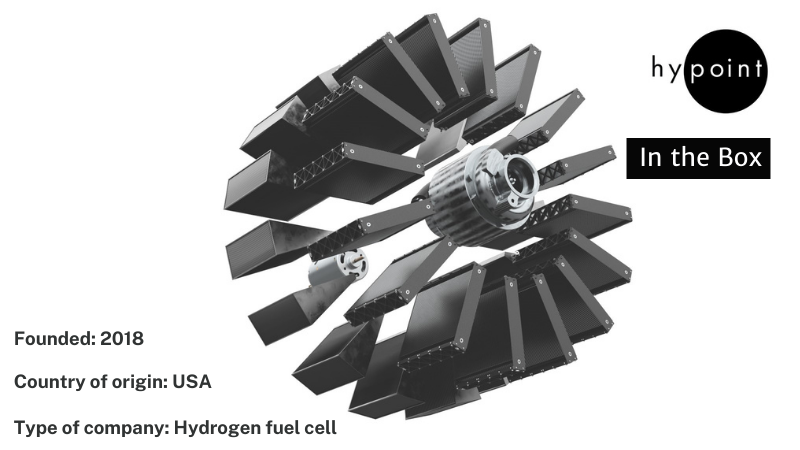Revolution.Aero Uplift: Leaving on a (Hydrogen) Jet Plane

exc-614ae486b1259924f819698b
If John Denver was still alive, he would need to tweak his song Leaving on a Jet Plane to make it appropriate for the hydrogen age. This would then fit the dream that Dr Alex Ivanenko – founder and CEO of hydrogen-cell technology company HyPoint – has for his daughters, whom he wants to see fly on hydrogen-powered regional jets in his lifetime.
He is starting by launching a company which aims to provide hydrogen fuel cells from logistics drones and eVTOL air taxis to helicopters and wide-body jets.
With greenhouse gas emissions from aviation expected to grow up to 25% between now and 2050, alternative fuels such as hydrogen are more than essential. HyPoint’s solution is based on LTPEM (Low Temperature Proton-Exchange Membrane) and HTPEM (High Temperature Proton-Exchange Membrane) fuel cells. According to the company, these allow HyPoint to develop a lightweight, more efficient cooling system. Ivanenko says the idea is to create a platform which will be able to serve various eVTOL manufacturers’ specific requirements.
Ivanenko tells Revolution.Aero: “We see that there are different requirements but our idea is to create a unique solution which might be customised for different eVTOL makers.”
Earlier this summer, HyPoint bagged $6.5m of funding and a partnership with helicopter OEM Piasecki Aircraft. This brings the startup’s total funding to about $10m. Together, the companies want to launch the world’s first manned, hydrogen helicopter, PA-890.
The $6.5m deal also includes six full-scale systems for demo flying, ground tests and certification, says Ivanenko.
John Piasecki, president and CEO of Piasecki said: “Our objective is to develop full-scale systems within two years to support on-aircraft certification testing in 2024 and fulfill existing customer orders for up to 325 units starting in 2025.”
HyPoint used its initial solution – the Short Stack – to validate the data predictions from individual contractors such as National Renewable Energy Lab. About 70% of the HyPoint system will be the same across the board, but Ivanenko says the PA-890 will have slightly different requirements from, say, the Airbus H125.
“The Short Stack was a very important milestone in our path, because there are a lot of technological and fundamental validations in that prototype,” said Ivanenko. “We believe the certified, commercial product will be ready to use by 2025.”
The PA-890 will be the world’s first manned hydrogen helicopter.
Next steps
Ivanenko and his team have a vision to bring hydrogen fuel to drones, helicopters and air taxis. Next would be wide body jets. “I strongly believe we will see hydrogen-powered jets in my life. My daughters will use hydrogen-powered regional jets in their lives,” he said.
But they do not want to take on more than they can deliver.
The company is aiming to complete its first 20kw single-power module and gather some data from it by early next year. Then, it will aim to deliver a 150kw, full-scale system for a demonstration flight, for ZeroAvia, by the end of 2022 or early 2023. And in 2023, HyPoint hopes to build Piasecki’s system for ground testing.
ZeroAvia, an established name in the hydrogen fuel cell market, is one of the company’s other announced partners which will help with research and development. HyPoint is building its R&D and production site in the UK. Ivanenko says: “Right now we are considering two main markets: the UK and US. The UK specifically is the capital of hydrogen aviation. It supports many initiatives and is two years ahead of the US. Both have a high level of acceptance to the technology.”
Top priority for Ivanenko is to have the product delivered on time. “As soon as we do this, we can start to think about expanding to Africa, Asia and other regions,” he said.
One of the big benefits for existing airframers and operators is the promise of lower operational costs.
The cost of hydrogen now is $16/kg. At this price, HyPoint and Piasecki believe hydrogen-powered helicopters could have 25% lower operating costs than traditional helicopters, says Ivanenko. They expect hydrogen prices to drop further to $3/kg.
There will also be cost incentives to using alternative fuels over carbon-based ones in the near future, which will make these attractive to more established aviation companies.
Val Miftakhov, founder and CEO, ZeroAvia, agrees that the cost is a big benefit of hydrogen. He tells Revolution.Aero: “Hydrogen-electric will be cheaper than traditional propulsion – both in fuel costs and maintenance – within the next three to five years. Also, hydrogen production is possible at any location there is electricity, which means much easier logistics for remote operations.”
Ivanenko adds to this: “I don’t think it will be a big deal for helicopters to use hydrogen at all. The infrastructure is a question of a few million dollars investment in any airport that wants to use hydrogen.”
Airports have the necessary certificates to use hydrogen already, but Ivanenko says the questions arise with storage tanks and additional filling infrastructure. “You don’t need to reorganise completely your airport’s design,” he said.
However, one thing which will help Ivanenko get closer to his dream of wide-body jet flights using hydrogen is supply. “My main concern is the volume of hydrogen. Now, it seems that we have to increase by many times the generation of hydrogen,” he said.








